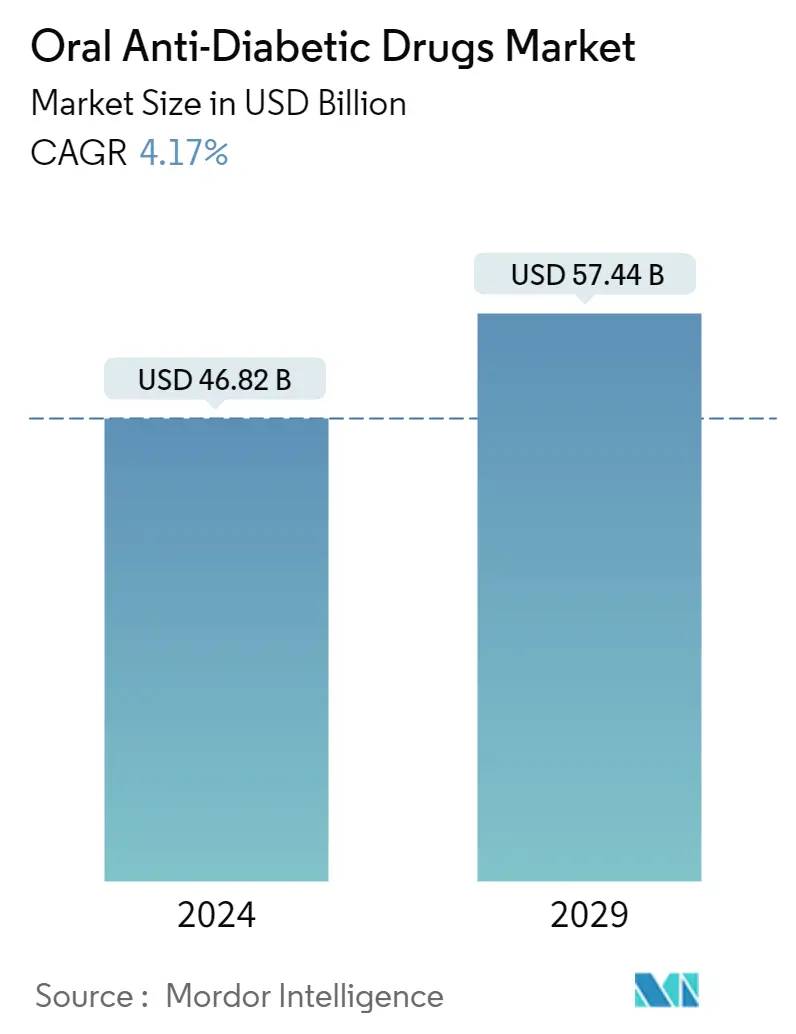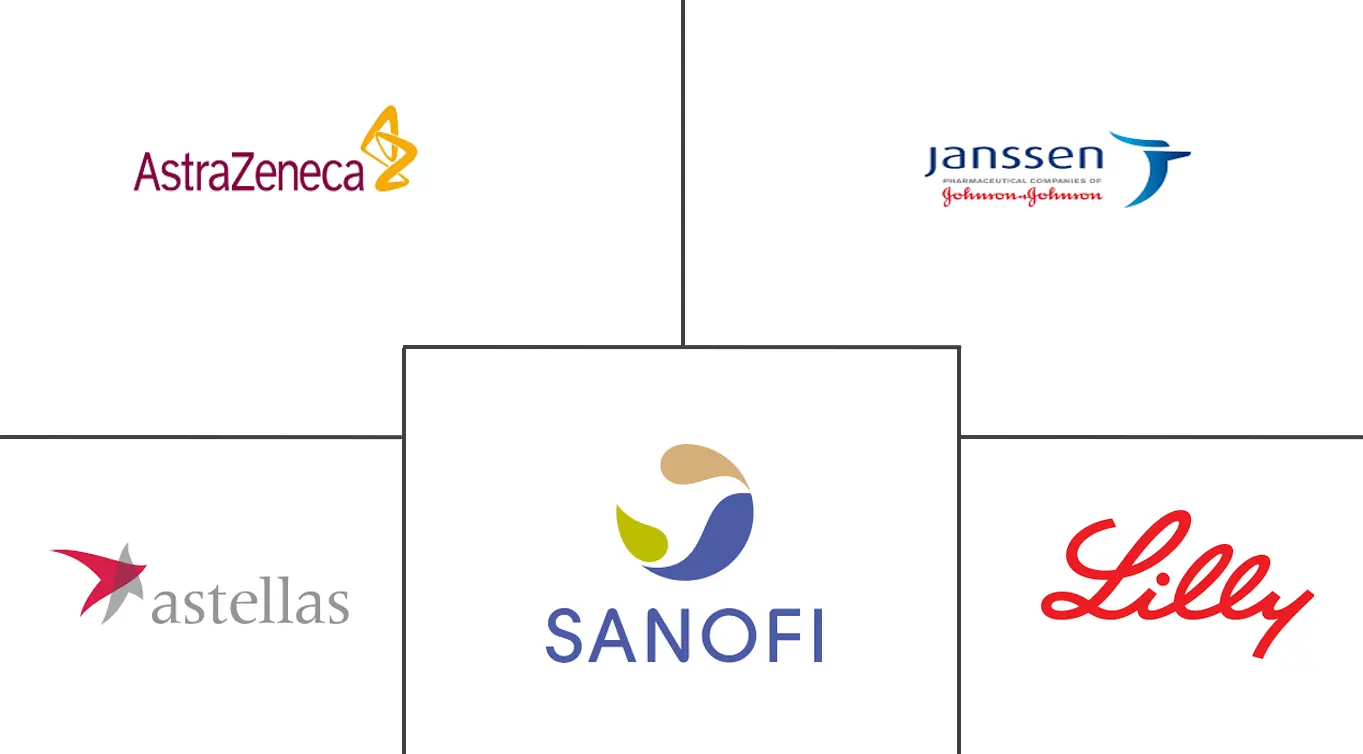Market Size of Oral Anti-Diabetic Drugs Industry

| Study Period | 2018 - 2029 |
| Market Size (2024) | USD 46.82 Billion |
| Market Size (2029) | USD 57.44 Billion |
| CAGR (2024 - 2029) | 4.17 % |
| Fastest Growing Market | Asia-Pacific |
| Largest Market | Asia-Pacific |
Major Players
*Disclaimer: Major Players sorted in no particular order |
Oral Anti Diabetic Drugs Market Analysis
The Oral Anti-Diabetic Drugs Market size is estimated at USD 46.82 billion in 2024, and is expected to reach USD 57.44 billion by 2029, growing at a CAGR of 4.17% during the forecast period (2024-2029).
The market is estimated to reach a value of more than USD 52 billion by 2027.
The COVID-19 pandemic has had a substantial impact on the oral anti-diabetic drugs market. The prevalence of diabetes in people hospitalized with COVID-19 infection and the recognition that improved glycemic control might improve outcomes and reduce the length of stay in patients with SARS-CoV-2 have underlined the importance of the oral anti-diabetic drugs market. People with diabetes have a weaker immune system, the COVID-19 complication aggravates the condition, and the immune system gets weaker very fast. Diabetes and uncontrolled hyperglycemia are risk factors for poor outcomes in patients with COVID-19 including an increased risk of severe illness or death. Thus, the COVID-19 outbreak increased the oral anti-diabetic drugs market's growth globally.
According to International Diabetes Federation (IDF), the adult diabetes population in 2021 is approximately 537 million, and this number is going to increase by 643 million in 2030. The rate of newly diagnosed cases of Type 1 and Type 2 diabetes is seen to increase, mainly due to obesity, unhealthy diet, and physical inactivity. The rapidly increasing incidence and prevalence of diabetic patients and healthcare expenditure worldwide are indications of the increasing usage of anti-diabetic drugs. Technological advancements and innovations have increased over the period leading to several modifications either in the drugs or the formulations being developed.
Therefore, owing to the aforementioned factors the studied market is anticipated to witness growth over the analysis period.
Oral Anti Diabetic Drugs Industry Segmentation
Oral diabetes drugs help manage blood glucose levels in patients whose bodies still produce some insulin, such as those with type 2 diabetes. These medicines are prescribed along with regular exercise and changes in the diet. The Oral Anti-Diabetic Drugs Market is segmented into drugs (Biguanides (Metformin), Alpha-glucosidase inhibitors, Dopamine-D2 receptor agonists (Bromocriptin (Cycloset)), Sodium-glucose Cotransport-2 (SGLT-2) inhibitor (Invokana (Canagliflozin), Jardiance (Empagliflozin), Farxiga/Forxiga (Dapagliflozin), and Suglat (Ipragliflozin)), Dipeptidyl Peptidase-4 (DPP-4) Inhibitors (Januvia (Sitagliptin), Onglyza (Saxagliptin), Tradjenta (Linagliptin), Vipidia/Nesina (Alogliptin), and Galvus (Vildagliptin)), Sulfonylureas, and Meglitinides), and Geography (North America, Europe, Asia-Pacific, Middle East and Africa, and Latin America). The report offers the value (in USD million) and volume (in units million) for the above segments. Further, the report will cover a segment-wise breakdown (value and volume) for all the countries covered under the Table of Contents.
| Drugs | |||||||
| |||||||
| |||||||
| |||||||
| |||||||
| |||||||
| |||||||
|
| Geography | |||||||||||||
| |||||||||||||
| |||||||||||||
| |||||||||||||
| |||||||||||||
|
Oral Anti-Diabetic Drugs Market Size Summary
The oral anti-diabetic drugs market is poised for significant growth over the forecast period, driven by the increasing prevalence of diabetes and the rising demand for effective treatment options. The market's expansion is further fueled by the impact of the COVID-19 pandemic, which highlighted the importance of glycemic control in improving patient outcomes. The growing incidence of diabetes, largely attributed to factors such as obesity and sedentary lifestyles, underscores the need for anti-diabetic medications. Technological advancements and innovations in drug formulations have also contributed to the market's growth, with biguanides, particularly metformin, holding a substantial market share due to their proven efficacy and cost-effectiveness. The market is characterized by a moderate level of fragmentation, with major global players like Eli Lilly, AstraZeneca, and Sanofi maintaining a strong presence, while regional players continue to emerge, particularly in the Asia-Pacific region.
The Asia-Pacific region is expected to witness robust growth, driven by the increasing diabetic population in countries like China and Japan. The introduction of new-generation oral drugs, such as DPP-4 and SGLT-2 inhibitors, is anticipated to further boost market growth by reducing cardiovascular risks in diabetic patients. The market landscape is also evolving with the launch of innovative products, such as Glenmark's sitagliptin-based drugs in India and Oramed's oral insulin capsule, which could potentially transform diabetes management. Despite the challenges posed by an aging population and economic factors in mature markets like Japan, the overall market trajectory remains positive, supported by the ongoing development of new therapies and the expanding spectrum of diabetes medications.
Oral Anti-Diabetic Drugs Market Size - Table of Contents
-
1. MARKET DYNAMICS
-
1.1 Market Overview
-
1.2 Market Drivers
-
1.3 Market Restraints
-
1.4 Porter's Five Forces Analysis
-
1.4.1 Bargaining Power of Suppliers
-
1.4.2 Bargaining Power of Consumers
-
1.4.3 Threat of New Entrants
-
1.4.4 Threat of Substitute Products and Services
-
1.4.5 Intensity of Competitive Rivalry
-
-
-
2. MARKET SEGMENTATION
-
2.1 Drugs
-
2.1.1 Biguanides
-
2.1.1.1 Metformin
-
-
2.1.2 Alpha-glucosidase inhibitors
-
2.1.2.1 Alpha-glucosidase Inhibitors
-
-
2.1.3 Dopamine -D2 Receptor Agonist
-
2.1.3.1 Bromocriptin (Cycloset)
-
-
2.1.4 Sodium-glucose Cotransport -2 (SGLT-2) inhibitor
-
2.1.4.1 Invokana (Canagliflozin)
-
2.1.4.2 Jardiance (Empagliflozin)
-
2.1.4.3 Farxiga/Forxiga (Dapagliflozin)
-
2.1.4.4 Suglat (Ipragliflozin)
-
-
2.1.5 Dipeptidyl Peptidase - 4 (DPP-4) Inhibitors
-
2.1.5.1 Januvia (Sitagliptin)
-
2.1.5.2 Onglyza (Saxagliptin)
-
2.1.5.3 Tradjenta (Linagliptin)
-
2.1.5.4 Vipidia/Nesina (Alogliptin)
-
2.1.5.5 Galvus (Vildagliptin)
-
-
2.1.6 Sulfonylureas
-
2.1.6.1 Sulfonylureas
-
-
2.1.7 Meglitinides
-
2.1.7.1 Meglitinides
-
-
-
2.2 Geography
-
2.2.1 North America
-
2.2.1.1 United States
-
2.2.1.2 Canada
-
2.2.1.3 Rest of North America
-
-
2.2.2 Europe
-
2.2.2.1 France
-
2.2.2.2 Germany
-
2.2.2.3 Italy
-
2.2.2.4 Spain
-
2.2.2.5 United Kingdom
-
2.2.2.6 Russia
-
2.2.2.7 Rest of Europe
-
-
2.2.3 Latin America
-
2.2.3.1 Mexico
-
2.2.3.2 Brazil
-
2.2.3.3 Rest of Latin America
-
-
2.2.4 Asia-Pacific
-
2.2.4.1 Japan
-
2.2.4.2 South Korea
-
2.2.4.3 China
-
2.2.4.4 India
-
2.2.4.5 Australia
-
2.2.4.6 Vietnam
-
2.2.4.7 Malaysia
-
2.2.4.8 Indonesia
-
2.2.4.9 Philippines
-
2.2.4.10 Thailand
-
2.2.4.11 Rest of Asia-Pacific
-
-
2.2.5 Middle East and Africa
-
2.2.5.1 Saudi Arabia
-
2.2.5.2 Iran
-
2.2.5.3 Egypt
-
2.2.5.4 Oman
-
2.2.5.5 South Africa
-
2.2.5.6 Rest of Middle East and Africa
-
-
-
Oral Anti-Diabetic Drugs Market Size FAQs
How big is the Oral Anti-Diabetic Drugs Market?
The Oral Anti-Diabetic Drugs Market size is expected to reach USD 46.82 billion in 2024 and grow at a CAGR of 4.17% to reach USD 57.44 billion by 2029.
What is the current Oral Anti-Diabetic Drugs Market size?
In 2024, the Oral Anti-Diabetic Drugs Market size is expected to reach USD 46.82 billion.

